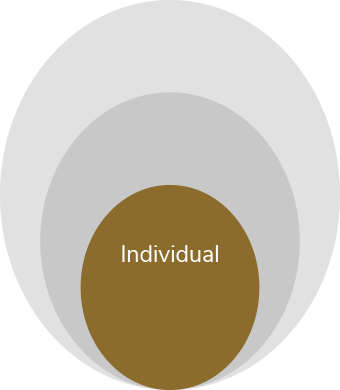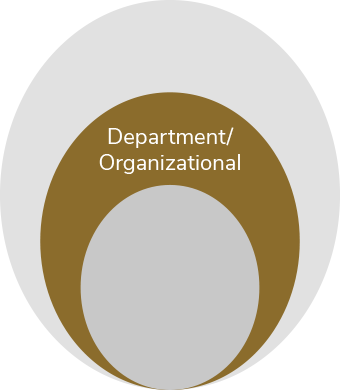R.I.D.E. Framework: Guiding Questions, Tools and Resources
R.I.D.E. is Wake Forest University’s institutional framework for Inclusive Excellence. R.I.D.E. stands for Realizing Inclusion, Diversity, and Equity, and the framework outlines the areas that Wake Forest will focus on as individuals, as organizations and departments, and as an institution to work towards Inclusive Excellence.
*This is a dynamic and evolving resource. Please check back regularly for updates.
R.I.D.E. Resources
On the R.I.D.E website:
On the ODI website:
At an Individual Level

- How do I define and understand key concepts? (e.g. inclusion, diversity, equity, unconscious bias, accessibility, intersectionality, etc.)
- How do I increase my self-awareness of the identities I hold and how those identities impact my relationships with others?
- How do I understand the identities of others?
- How do I affirm the identities of others? (e.g. using names and pronouns, disability, gender identity, etc.)
- How do I enhance my personal knowledge of the history, ideology, and current manifestations of systemic inequalities and how they reinforce each other?
- How do I demonstrate understanding and empathy for the identity experiences of others?
- How do I understand the complexity of terms and concepts related to the identities of others?
- How do I actively seek out opportunities to understand accessibility, social identities, diversity, equity, and inclusion, by engaging in dialogue with people who are different from me?
How do I feel respected, valued, accepted, cared for, included, and that I matter at Wake Forest University?
- What beliefs do I hold about people from different backgrounds being able to succeed at Wake Forest University (e.g. students across different backgrounds in my course(s), colleagues across difference backgrounds, etc.)?
- What personal biases do I hold?
- How do my personal biases affect the way that I engage with others?
- How do I value and appreciate ways of being, doing, and thinking other than my own?
- How am I able to/do I safely intervene in situations that can cause harm to others sense of inclusion and equity? (e.g. speaking against the telling of a racist joke)
- How do I use my identities of privilege for effective bystanding or allyship for under-represented or marginalized identities?
- How do I engage in ways that demonstrate understanding and respect for cultural differences and how they manifest in the Wake Forest University environment?
- How do I engage in behaviors that demonstrate fairness, respect, dignity, and generosity to all people?
- How do I demonstrate understanding and respect for cross-cultural differences in engagement? (e.g. time, eye contact, language fluency, accessible options, direct communication, tone and volume of speech, etc.)
- How do I create space for values and beliefs that are different from my own?
- How do I hold myself accountable to ongoing self-development, including self-education, self-reflection, and personal change?
- How do I experience Wake Forest University in a way that aligns with a value for accessibility, inclusion, diversity, and equity?
- How often and in what ways do I experience or witness acts of bias or discrimination related to race, ethnicity, gender, sexual orientation, age, disability, religion, national origin, socioeconomic status, etc.?
At a Departmental, Organizational, or Unit Level

- How diverse is the membership of my organization or department? (e.g. racially, ethnically, gender identity and expression, sexual orientation hierarchically, language, disability, religion, age, etc.) represented within and across the levels of my organization, department, or unit? (Hierarchical, tenure track vs. teaching track, senior administration vs. lower or middle level, etc.)
- How are diverse voices and experiences lifted as relevant in the curriculum and programming?
- How does my department, organization, or unit support pathways for leadership for individuals across a diverse range of identities and backgrounds?
- How does my department, organization, or unit prioritize or create space for training, professional development, dialogue, or other opportunities that support accessibility, inclusion, diversity, and equity? (e.g. professional development funds, time off/flexible schedule, scholarships, etc.)
- How does my department, organization or unit make decisions to stop the efforts that aren’t working or supportive of an inclusive environment?
- How is budgeting, resource allocation and fundraising developed and by whom?
- How does my department, organization, or unit create a diverse prospective member/applicant pool?
- How is a diversity of voices and perspectives leveraged in hiring decisions?
- How does the culture of my department, organization, or unit create space for longevity for people across a range of diverse identities and backgrounds? (e.g. retention planning for URMs)
- How do individuals with a range of diverse identities and backgrounds sustain engagement with my department, organization, or unit?
- What is required to ensure individuals with historically underrepresented and/or marginalized identities receive opportunities for promotion and/or advancement?
- How does my department, organization, or unit connect inclusive excellence to hiring, merit, or opportunities for advancement?
- How are individuals with historically underrepresented and/or marginalized identities supported formally and informally in building community and longevity?
- How are individuals form a broad range of backgrounds and identities equitably accessing the range of opportunities, experience, and resources available through the department, organization, or unit (e.g. training, mentoring, leadership opportunities, etc.)
- How do “unofficial” meeting spaces create inequitable access to opportunities? (e.g. job offerings based upon who you know, invitations to social gathering with power brokers, special invitations to committees, etc.)
- How does my department, organization, or unit engage the broader body in visioning and decision-making?
- How does my department, organization, or unit communicate direction and decisions, as well as their rationale, to the broader body? (e.g. hiring, organizational processes, resource availability, etc.)
- How does my department, organization, or unit transparently use data to impact DEI direction and efforts?
- How does everyone understand the process through which decisions are made, who has decision-making power and who does not?
- How do we regularly and accurately receive feedback about our departmental, organizational, or unit processes, practices, and climate?
How do the traditions and practices that are observed in my department, organization, or unit differentially impact individuals across a broad range of different backgrounds and identities? (e.g. birthday celebrations, toilet papering the Quad, etc.)
- How are members of my department, organization or unit, particularly across hierarchy or identity, held to the same expectations and level of accountability?
- How does my department, organization, or unit prioritize or integrate DEI into operations?
- How does my department, organization, or unit attempt to screen out implicit bias in our practices and policies?
- How are leaders accountable for prioritizing a diverse, inclusive, and equitable leadership style?
- How is there a shared understanding of the criteria for advancement?
- How is equity demonstrated in performance management and/or career advancement?
- How are individuals with different academic, scholarly and professional goals valued equally? (e.g. tenure vs non-tenure track, those doing DEI or community-engaged work, etc.)
- How do individuals across a range of diverse identities and backgrounds experience incidents of harassment based upon their identity?
- What are the intergroup relations and behaviors within the department, organization, or unit?
- How has the department, organization, or unit made an expressed commitment to DEI?
- How is DEI authorized in organizational, departmental, or unit policy and practice?
- How are discussions and work around DEI viewed as essential to all the work and encouraged rather than viewed as distractions from the “real work”?
- How does the department, organization, or unit partner or engage with the broader Winston-Salem communities in a manner that respects mutual benefit, power sharing, shared priority setting, resource sharing, and sustainability?
At an Institutional Level

- How are individuals from a diverse range of identities and backgrounds represented across the senior leadership of the institution and governing bodies? (e.g. racially, ethnically, gender identity and expression, accessibility, sexual orientation hierarchically, language, ability, religion, age, etc.)
- How are individuals from a diverse range of identities and backgrounds represented across the levels of the institution? (Board of Trustees, Divisional and departmental leadership, mid-level, service industries, etc.)
- How are diverse voices and experiences lifted as relevant in institutional discourse?
- How does the institution support pathways to institutional leadership across individuals from a diverse range of identities and backgrounds?
- How does the institution prioritize or create space for training, professional development, dialogue, or other opportunities that support accessibility, inclusion, diversity, and equity? (e.g. professional development funds, time off/flexible schedule, scholarships, staffing, infrastructure, etc.)
- How does the institution make decisions to stop the efforts that aren’t working or supportive of an inclusive environment?
- What is differentially necessary for individuals from diverse backgrounds to access “membership” or to feel included in the WFU community? (e.g. financially, language, connection to alum, etc.)
- How does the institution intentionally recruit students, faculty, and staff representing a diverse range of identities and backgrounds? (e.g. race/ethnicity, socioeconomic status, language, place of origin, gender, disability, sexual orientation, religion, etc.)
- How does the institution intentionally retain students, faculty, and staff representing a diverse range of identities and backgrounds? (e.g. race/ethnicity, socioeconomic status, language, place of origin, disability, gender, sexual orientation, religion, etc.)
- How does the institution engage students, faculty, and staff in visioning and decision-making? (e.g. Review of the Student Code of Conduct, selection of senior leadership, etc.)
- How does the institution communicate institutional direction and decisions, as well as their rationale, to the broader body? (e.g. hiring, institutional processes, accessibility, resource availability, etc.)
- How does the institution demonstrate clear and transparent policies and procedures that govern how we conduct business?
- How does the institution regularly and accurately receive feedback about institutional processes, practices, and climate?
- How do the traditions and practices that are observed by the institution differentially impact those with a diverse range of identities and backgrounds?
- How are a diverse range of identities and backgrounds represented in institutional traditions and practices? (e.g. Founder’s Day, etc.)
- How are institutional leaders, particularly across hierarchy or identity, held to the same expectations and accountabilities? (e.g. support of DEI initiatives, fiscal management, work conditions, etc.)
- How does the institution explicitly prioritize or integrate DEI into institutional operations, policies, and practices?
- How does the institution support the development and proliferation of DEI scholarship, incubators, community, and strategic leadership? (e.g. personnel, fiscal support, institutional visibility, authority vs. influence, etc.)
- How are institutional leadership positions prioritizing DEI (e.g. hiring, strategic planning, resource allocation, operations, etc.)?
- How are positions that prioritize DEI positioned, prioritized, and resourced within the institution?
- How do individuals across a diverse range of identities experience incidents of harassment based upon their identity?
- What is the institutional culture, attitudes, and practices towards groups representing a diverse range of identities and backgrounds?
- What are the intergroup relations and behaviors within the institution?
- How does the institution partner or engage with the broader Winston-Salem communities in a manner that respects mutual benefit, power sharing, shared priority setting, accessibility, resource sharing, and sustainability? (e.g. supplier diversity, etc.)
- How does the institution support community engagement initiatives? (e.g. fiscal, staffing, positionally, etc.)
- How do institutional community engagement initiatives support equitable community development? (e.g. supporting under-resourced areas, partnering with local or URM businesses, etc.)
© 2020 by Wake Forest University. All rights reserved.
